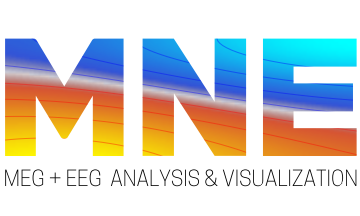
The MNE-Python project provides a full tool stack for processing and visualizing electrophysiology data. That is, electroencephalography (EEG), magnetoencephalography but also intracranial EEG. MNE-R facilitates integrating this mature and extensive functionality into R-based data processing, visualization and statisticasl modeling. This is made possible through the reticulate package, which enables seamless integration of Python into R.
Currently, MNE-R is focussing on documenting how to use MNE-Python through R, based on familiar MNE-examples while also showcasing what R can add to the game in terms of statistics and visualization functionality.
In the future, more R-functions may be added that facilitate the interaction with MNE-Python or implement complementary functionality.
The project is open to contributions.
Getting Started
In order to use MNE-R, MNE-Python has to be installed with all its dependencies. Some configuration may be needed to make sure reticulate knows which Python installation to use. Please consider the reticulate and the MNE documentation. We generally recommend using the Anaconda Python distribution and Python 3 instead of Python 2.
For seamlessly combining R and Python code in one Rmarkdown script, the latest Rstudio 1.2 is needed.
Currently, MNE-R can be installed from github.
To get started, simply laod the mne library
library(mne) # load mne and get the mne object
#> Importing MNE version=0.18.dev0, path='/Users/dengeman/github/mne-python/mne'
# the mne object wraps the loaded mne module inside Python
print(names(mne)[1:10])
#> [1] "AcqParserFIF" "add_reference_channels"
#> [3] "add_source_space_distances" "annotations"
#> [5] "Annotations" "apply_forward"
#> [7] "apply_forward_raw" "average_forward_solutions"
#> [9] "BaseEpochs" "baseline"
# use dollar signs to access MNE modules, functions and objects
cat(mne$datasets$sample$data_path$`__doc__`)
#> Get path to local copy of sample dataset.
#>
#> Parameters
#> ----------
#> path : None | str
#> Location of where to look for the sample dataset.
#> If None, the environment variable or config parameter
#> ``MNE_DATASETS_SAMPLE_PATH`` is used. If it doesn't exist, the
#> "~/mne_data" directory is used. If the sample dataset
#> is not found under the given path, the data
#> will be automatically downloaded to the specified folder.
#> force_update : bool
#> Force update of the sample dataset even if a local copy exists.
#> update_path : bool | None
#> If True, set the ``MNE_DATASETS_SAMPLE_PATH`` in mne-python
#> config to the given path. If None, the user is prompted.
#> download : bool
#> If False and the sample dataset has not been downloaded yet,
#> it will not be downloaded and the path will be returned as
#> '' (empty string). This is mostly used for debugging purposes
#> and can be safely ignored by most users.
#>
#> verbose : bool, str, int, or None
#> If not None, override default verbose level (see :func:`mne.verbose`
#> and :ref:`Logging documentation <tut_logging>` for more).
#>
#> Returns
#> -------
#> path : str
#> Path to sample dataset directory.Troubleshooting and known issues.
- If knitting Python chunks inside Rmarkdown fails, it is most likely a problem of telling
reticulatewhich Python interpreter to use. To use the recommended Python 3 from Aanaconda, assuming it is installed, you can include this line in your.bashrc(Linux) or.bash_profile(Mac):
- Also make sure your Python installation is ok. If you cannot run the Python code of interest using the Python interpreter, the problem is there. For exampple, make sure that inside the Python interpreter importing
mneworks.
This should not give you any error message.
For optimal Python and
reticulatesupport in Rstudio, make sure you have the latest version of Rstudio.Currently, when making matplotlib figures from within R, the resulting image will not be rendered inside the Rstudio Rmarkdown chunk. You will need to save, load and display the figure or explicitly, write Python code in a Python chunk, or explicitly make maptlotlib open a window:
library(mne)
plt <- import("matplotlib.pyplot") # get matplotlib handle
data_path <- mne$datasets$sample$data_path()
raw_fname <- paste(data_path,
'MEG',
'samlpe',
'sample_audvis_filt-0-40_raw.fif',
sep = '/')
raw <- mne$io$read_raw_fif(raw_fname)
raw$plot() # plot it!
plt$show() # show the figure, then search for the window popping up.Some of the examples may depend on the latest MNE-Python code. We will try to provide patches little by little in MNE-Python or here.
Currently, if 32-bit and 64-bit versions of R are installed, it seems devtools tries to build for both of them. This yields a
loading failed for 'i386'error. To force building the package for your currently running R version use theINSTALL_optsargument ofinstall_github: